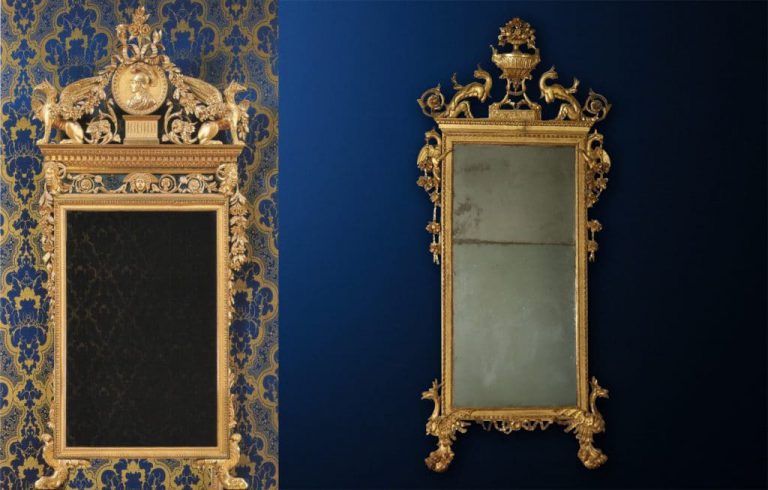- Neoclassical mirror, Florence, late eighteenth century
Countertop mirror, richly and finely carved in lime wood and gilded. The rectangular frame is made of a burin with an opaque gold finish and held by an internal beaded edge and a ribbon with leaves on the outside; two chimeras are placed on the pediment-shaped architectural coping with a central vase of carved flowers of clear classic taste, supported by two legs with a feral foot and with two lateral masks; on the sides two other winged chimeras clinging to the frame hold two floral festoons in their mouths that descend along the sides of the frame.
The feet of the mirror are again two chimeras, but this time with two feral feet and not feathered but dragon wings; between the two an elegant ribbon closes in a central knot.
The mirror is made of carved and gilded lime wood with a rosy bole as typical in Florence, the mirrors, coeval, are mercury.
Dimensions: 210 x 87 cm (82,7 x 34,2 in)
The modernization work promoted by the Grand Duke Pietro Leopoldo (in Florence since 1765), will lead to the abandonment of the Tuscan late-Baroque taste for the more modern neoclassicism, inspired by Roman villas and those findings of Neapolitan excavations that were quickly conquering and fascinating all of Europe .
The Grand Duke’s choice to entrust the young Giocondo Albertolli with the ornate works of the palaces will prove decisive; the modernity and novelty of the artist’s works will be the first samples from which the new classic taste will draw inspiration. It will be Pietro Leopoldo who advised his brother Ferdinando to hire Albertolli in Milan, where he will also be in charge of the direction of the chair of ornate at the Brera Academy.
The Florentine neoclassicism and that of Albertolli will not only look at Roman classicism, but will be positively influenced by the rereading that the Renaissance homeland had already given of the Roman stylistic canons in the fifteenth century.
To this historical-stylistic premise it must be added that Florence enjoyed the fortune, unlike cities like Milan, of having skilled workers, coming from all over Europe, not only in stone and semiprecious stone works, but also in menusieri, carvers, gilders , cabinetmakers etc.
Prestigious are the carving works published in the texts that contain the collections of the Florentine palaces; the shops mentioned in the inventories are numerous, the most prestigious undoubtedly that of Lorenzo Dolci (who succeeded his father Giovan Battista) but also Odoardo Wyndham, Carlo Toussaint etc.

In this regard, it must be said that the execution of the mirror described here is of great quality, first of all in terms of invention, execution and finally of gilding. It is evidently comparable to some published mirrors, first of all to the mirror inventoried in the Palazzo Granducale in Livorno and created by Lorenzo Dolci in 1798. The mirror preserved in the Ulysses room, in the Palatine Gallery, Palazzo Pitti, belongs to a very similar group. the feet are made of chimeras very similar to ours.
In the last twenty years of the eighteenth century therefore the mirror analyzed here should also be placed.
– Enrico Colle, Il mobile Rococò in Italia, ed. Electa 2003
– Enrico Colle, Il mobile neoclassico in Italia, ed. Electa 2005
– Simone Chiarugi, Botteghe di Mobilieri in toscana, ed. S.P.E.S. 1994
– Alvar Gonzalez-Palacios, Il tempio del gusto, ed. Longanesi 1986

FineArt is the new ambitious Di Mano in Mano project that offers an exclusive choice of antiques and design works, presenting them for their singularity and uniqueness.

FineArt by Di Mano in Mano is a team of experts at your service to enhance furniture, paintings, finest antiques, art and design masterpieces at best.
Di Mano in Mano
Via Castellazzo 8, Cambiago (MI)
20040